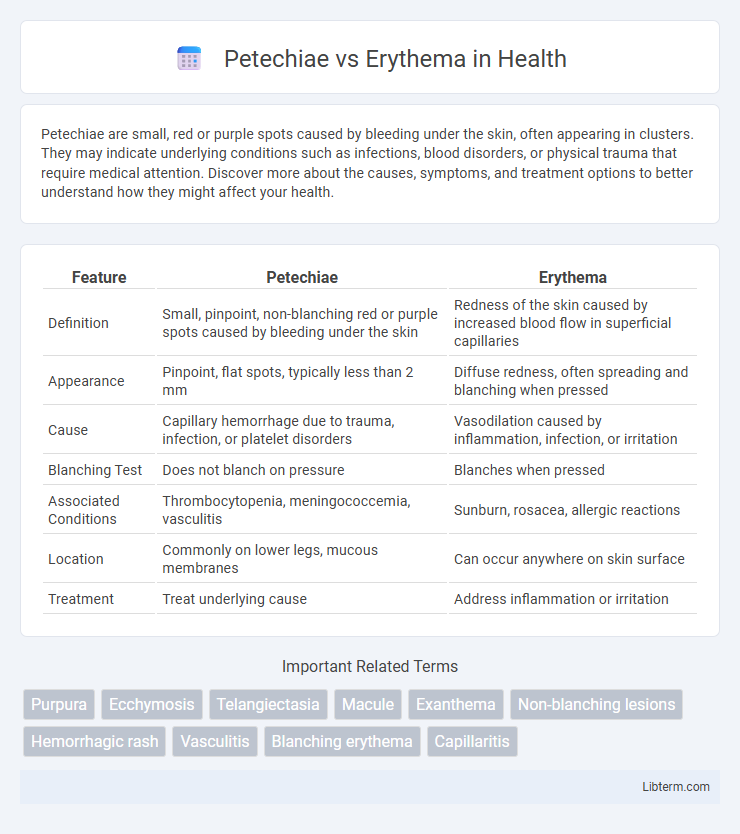Petechiae are small, red or purple spots caused by bleeding under the skin, often appearing in clusters. They may indicate underlying conditions such as infections, blood disorders, or physical trauma that require medical attention. Discover more about the causes, symptoms, and treatment options to better understand how they might affect your health.
Table of Comparison
| Feature | Petechiae | Erythema |
|---|---|---|
| Definition | Small, pinpoint, non-blanching red or purple spots caused by bleeding under the skin | Redness of the skin caused by increased blood flow in superficial capillaries |
| Appearance | Pinpoint, flat spots, typically less than 2 mm | Diffuse redness, often spreading and blanching when pressed |
| Cause | Capillary hemorrhage due to trauma, infection, or platelet disorders | Vasodilation caused by inflammation, infection, or irritation |
| Blanching Test | Does not blanch on pressure | Blanches when pressed |
| Associated Conditions | Thrombocytopenia, meningococcemia, vasculitis | Sunburn, rosacea, allergic reactions |
| Location | Commonly on lower legs, mucous membranes | Can occur anywhere on skin surface |
| Treatment | Treat underlying cause | Address inflammation or irritation |
Introduction to Petechiae and Erythema
Petechiae are small, pinpoint, red or purple spots caused by bleeding under the skin due to broken capillaries, often indicative of platelet or vascular abnormalities. Erythema refers to redness of the skin resulting from increased blood flow in superficial capillaries, commonly associated with inflammation, infection, or irritation. Differentiating petechiae from erythema is crucial for diagnosis, as petechiae do not blanch under pressure, while erythema typically does.
Defining Petechiae
Petechiae are tiny, pinpoint red or purple spots caused by minor bleeding from broken capillaries beneath the skin, often appearing in clusters. They are distinct from erythema, which is a broader area of skin redness resulting from increased blood flow and inflammation. Identifying petechiae is crucial for diagnosing conditions such as platelet disorders, vasculitis, or infections that affect blood vessel integrity.
Defining Erythema
Erythema is a medical condition characterized by redness of the skin caused by increased blood flow in superficial capillaries, often resulting from inflammation, infection, or injury. Unlike petechiae, which are small red or purple spots caused by minor bleeding under the skin, erythema presents as a diffuse redness without pinpoint hemorrhages. This vascular response is a common sign in dermatological assessments used to diagnose various underlying health issues.
Key Differences: Petechiae vs Erythema
Petechiae are small, pinpoint, non-blanching red or purple spots caused by capillary bleeding under the skin, typically appearing due to platelet disorders, trauma, or infections. Erythema presents as a widespread, blanching redness resulting from increased blood flow and inflammation, commonly associated with infections, allergies, or skin irritation. The key difference lies in petechiae's non-blanching nature and hemorrhagic origin, contrasting with erythema's blanching vascular dilation and inflammatory basis.
Common Causes of Petechiae
Petechiae are small, pinpoint red or purple spots caused by minor bleeding under the skin, frequently resulting from conditions like platelet disorders, infections such as meningococcemia, or physical trauma like prolonged straining. Unlike erythema, which is a widespread redness commonly associated with inflammation or allergic reactions, petechiae specifically indicate capillary hemorrhage. Recognizing petechiae requires evaluation for underlying causes including thrombocytopenia, vasculitis, or blood clotting abnormalities.
Common Causes of Erythema
Erythema commonly results from inflammation, infection, or physical factors like sunburn and allergic reactions, characterized by redness due to increased blood flow in capillaries. Petechiae, in contrast, are small red or purple spots caused by minor bleeding under the skin, often linked to platelet abnormalities, vascular disorders, or trauma. Understanding the distinct causes aids in diagnosing underlying conditions such as dermatitis or vasculitis for erythema and thrombocytopenia for petechiae.
Clinical Presentation and Visual Features
Petechiae present as small, pinpoint, non-blanching red or purple spots caused by capillary bleeding, often appearing in clusters on the skin or mucous membranes. Erythema manifests as widespread redness due to capillary dilation, typically blanching when pressed and varying in intensity depending on underlying inflammation or infection. Clinically, petechiae indicate vascular platelet or coagulation abnormalities, while erythema often reflects inflammatory or allergic reactions with erythematous rash patterns.
Diagnostic Approaches for Each Condition
Petechiae diagnosis primarily involves a thorough skin examination coupled with blood tests to assess platelet count and coagulation function, as these pinpoint underlying causes like thrombocytopenia or vasculitis. Erythema assessment relies on clinical evaluation of redness and inflammation patterns, supported by skin biopsy or allergy testing when autoimmune or hypersensitivity reactions are suspected. Both conditions may require dermoscopy and laboratory studies, but petechiae mandates urgent hematological workup to rule out serious systemic diseases.
Treatment and Management Options
Treatment for petechiae primarily involves addressing the underlying cause, such as infections, platelet disorders, or medication side effects, often requiring targeted therapies like antibiotics, corticosteroids, or platelet transfusions. Management of erythema depends on the specific condition causing redness, ranging from topical corticosteroids for inflammatory skin conditions to antihistamines for allergic reactions, and avoiding irritants or triggers to prevent recurrence. Both conditions benefit from dermatologist consultation for accurate diagnosis and tailored treatment plans to reduce symptoms and prevent complications.
When to Seek Medical Attention
Petechiae, small red or purple spots caused by bleeding under the skin, require immediate medical attention if they appear suddenly, spread rapidly, or are accompanied by symptoms such as fever, weakness, or unexplained bruising, as they may indicate serious conditions like infections or blood disorders. Erythema, characterized by redness of the skin often due to inflammation or infection, warrants a doctor's evaluation if it persists beyond a few days, spreads quickly, or is associated with pain, swelling, or fever, which could signal cellulitis or allergic reactions. Early medical intervention is crucial to diagnose underlying causes and prevent complications in both petechiae and erythema cases.
Petechiae Infographic

 libterm.com
libterm.com